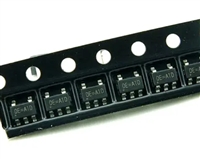STK11C88
DEVICE OPERATION
The STK11C88 is a versatile memory chip that pro-
SOFTWARE NONVOLATILE STORE
vides several modes of operation. The STK11C88
can operate as a standard 32K x 8 SRAM. It has a
32K x 8 Nonvolatile Elements shadow to which the
SRAM information can be copied or from which the
SRAM can be updated in nonvolatile mode.
The STK11C88 software STORE cycle is initiated by
executing sequential READ cycles from six specific
address locations. During the STORE cycle an erase
of the previous nonvolatile data is first performed,
followed by a program of the nonvolatile elements.
The program operation copies the SRAM data into
nonvolatile memory. Once a STORE cycle is initi-
ated, further input and output are disabled until the
cycle is completed.
NOISE CONSIDERATIONS
Note that the STK11C88 is a high-speed memory
and so must have a high-frequency bypass capaci-
tor of approximately 0.1µF connected between V
cc
Because a sequence of READs from specific
addresses is used for STORE initiation, it is impor-
tant that no other READ or WRITE accesses inter-
vene in the sequence or the sequence will be
aborted and no STORE or RECALL will take place.
and V , using leads and traces that are as short as
ss
possible. As with all high-speed CMOS ICs, normal
careful routing of power, ground and signals will help
prevent noise problems.
SRAM READ
To initiate the software STORE cycle, the following
READ sequence must be performed:
The STK11C88 performs a READ cycle whenever E
and G are low and W is high. The address specified
on pins A0-14 determines which of the 32,768 data
bytes will be accessed. When the READ is initiated
by an address transition, the outputs will be valid
after a delay of tAVQV (READ cycle #1). If the READ is
initiated by E or G, the outputs will be valid at tELQV or
at tGLQV, whichever is later (READ cycle #2). The data
outputs will repeatedly respond to address changes
within the tAVQV access time without the need for tran-
sitions on any control input pins, and will remain valid
until another address change or until E or G is
brought high.
1. Read address
2. Read address
3. Read address
4. Read address
5. Read address
6. Read address
0E38 (hex)
31C7 (hex)
03E0 (hex)
3C1F (hex)
303F (hex)
0FC0 (hex)
Valid READ
Valid READ
Valid READ
Valid READ
Valid READ
Initiate STORE cycle
The software sequence must be clocked with E con-
trolled READs.
Once the sixth address in the sequence has been
entered, the STORE cycle will commence and the
chip will be disabled. It is important that READ cycles
and not WRITE cycles be used in the sequence,
although it is not necessary that G be low for the
sequence to be valid. After the tSTORE cycle time has
been fulfilled, the SRAM will again be activated for
READ and WRITE operation.
SRAM WRITE
A WRITE cycle is performed whenever E and W are
low. The address inputs must be stable prior to
entering the WRITE cycle and must remain stable
until either E or W goes high at the end of the cycle.
The data on the common I/O pins DQ0-7 will be writ-
ten into the memory if it is valid tDVWH before the end
of a W controlled WRITE or tDVEH before the end of an
E controlled WRITE.
SOFTWARE NONVOLATILE RECALL
A software RECALL cycle is initiated with a sequence
of READ operations in a manner similar to the soft-
ware STORE initiation. To initiate the RECALL cycle,
the following sequence of READ operations must be
performed:
It is recommended that G be kept high during the
entire WRITE cycle to avoid data bus contention on
the common I/O lines. If G is left low, internal circuitry
will turn off the output buffers tWLQZ after W goes low.
1. Read address
2. Read address
3. Read address
4. Read address
5. Read address
6. Read address
0E38 (hex)
31C7 (hex)
03E0 (hex)
3C1F (hex)
303F (hex)
0C63 (hex)
Valid READ
Valid READ
Valid READ
Valid READ
Valid READ
Initiate RECALL cycle
September 2003
7
Document Control # ML0012 rev 0.1






 一文带你解读74HC244资料手册:特性、应用场景、封装方式、引脚配置说明、电气参数、推荐替代型号
一文带你解读74HC244资料手册:特性、应用场景、封装方式、引脚配置说明、电气参数、推荐替代型号

 AD623资料手册解读:特性、应用、封装、引脚功能及电气参数
AD623资料手册解读:特性、应用、封装、引脚功能及电气参数

 RT9193资料手册解读:RT9193引脚功能、电气参数、替换型号推荐
RT9193资料手册解读:RT9193引脚功能、电气参数、替换型号推荐

 VIPER22A的资料手册解读、引脚参数说明、代换型号推荐
VIPER22A的资料手册解读、引脚参数说明、代换型号推荐
